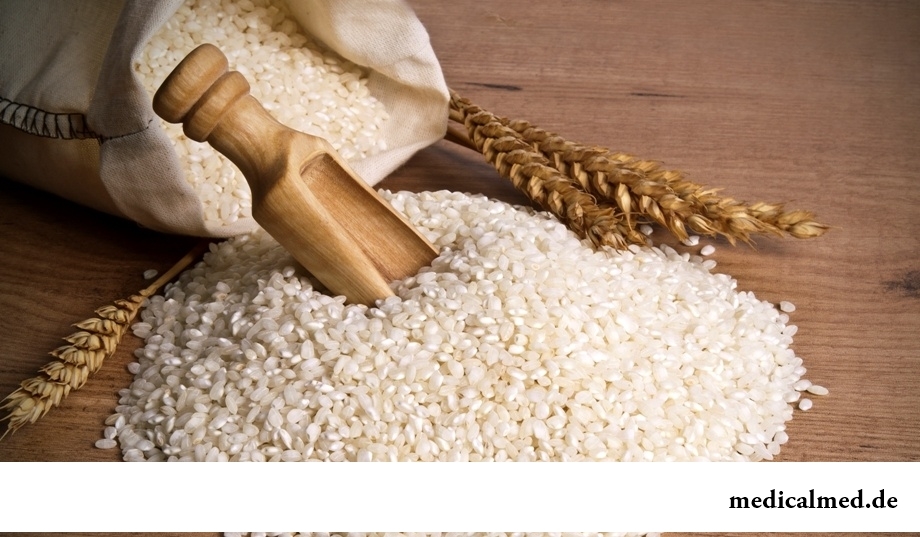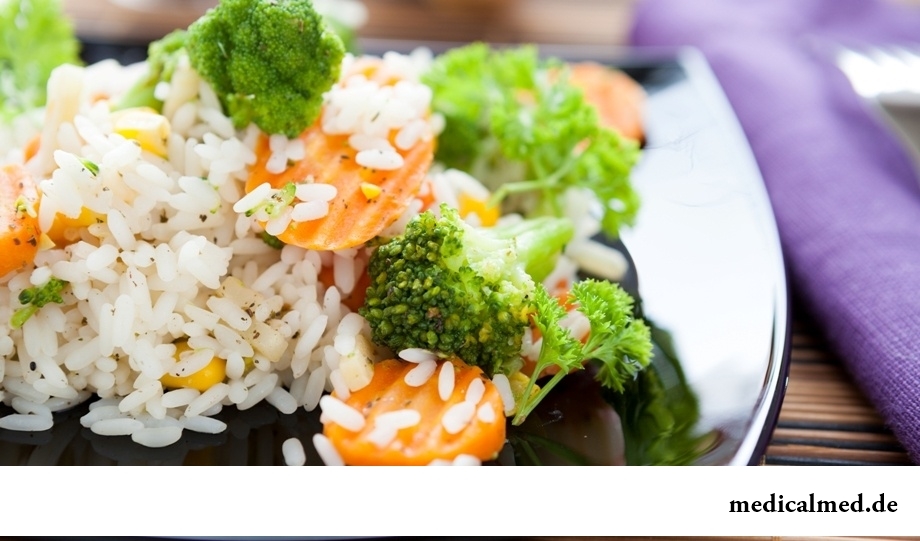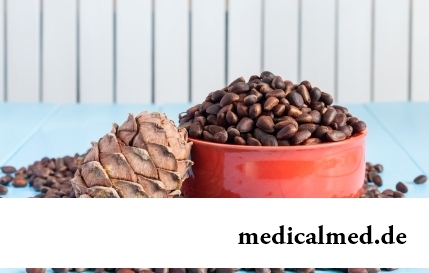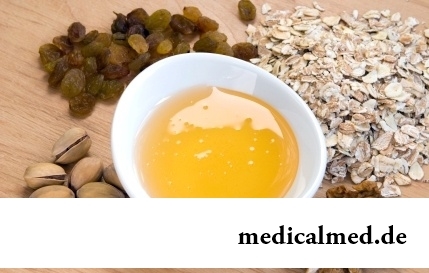





Rice
Rice is groat culture and concerns to family Cereals. This cultivated plant grows generally in tropical and subtropical regions of the planet, in particular, in Asia, America, Africa and Australia.

One of the most widespread crops is sowing campaign rice, to all other belonging to a number of the most ancient food crops. Domestication of rice contains more than 9 thousand years.
In our country the word "rice" began to be used only at the end of the 19th century, before it was called "saratsinsky wheat" or "saratsinsky grain", a bit later – "the Sorochinsk millet".
Rice in the modern world is used everywhere, however, approaches to its use differ. Conditionally they are divided on "east" which is characteristic of the countries of Asia and, respectively, "western" which is preferred in the countries of Europe and America. In the countries of Asia rice is an alternative to potatoes and wheat and makes a basis of many dishes. East culture of the use of rice in food is also curious: so, residents of the countries of Asia eat with hands the rice which stuck together in lumps, the same rule concerns also some sushi. Long-grain rice, friable and steamed, it is accepted to eat with sticks.
A variety of grades of a cereal is so big that to this day problematic their calculation is represented. To the most modest measures the kind of this cereal reaches 1000 grades. Classification of rice is carried out in several parameters: a type of processing, grain length, the price – here only some of them.
Nutrition value, structure and caloric content of rice
Despite variety of grades of rice, structure of a cereal it is almost identical. The product is vitamin-rich groups B, and also E and PP. Useful elements in its structure: iron, zinc, calcium, manganese, phosphorus, potassium, selenium.
Nutrition value of rice consists of the following indicators: 6,7 g of proteins; 0,7 g of fats; 78,9 g of carbohydrates. Caloric content of rice is defined, generally by the high content of carbohydrates. However it should not frighten those who keep a figure. The matter is that the carbohydrates which are contained in a cereal – difficult, so they for a long time sate and give energy to an organism, being slowly soaked up and acquired by an organism. Because the feeling of satiety even at the small use of this cereal comes quickly and lasts long. In spite of the fact that rice caloric content at the same time is rather high – about 344 Kcal on 100 g, it is almost impossible to exceed the day need for calories with it in connection with the above described properties.
Along with it rice consists for 8% from proteinaceous connections. It is also important to note that gluten – the phytalbumin guilty of developing of an allergy, – does not contain in it.
Useful properties of rice
Useful properties of rice of various grades are highly appreciated in the different countries throughout the millennia.
Thanks to the high content of potassium this product neutralizes salt from an organism, does not contain it. Such property of rice allows to recommend it at the diseases demanding observance of a diet with the low content of salt. Generally it concerns diseases of joints, and also disturbances, work-related kidneys or cardiovascular activity.
The complex of vitamins of group B which is contained in a cereal improves a condition of hair, skin and nails, and also strengthens a nervous system and participates in formation of energy from nutrients.
The advantage of rice at disturbances of functions of digestive tract is caused by the starch and cellulose which are contained in it which envelop and protect mucous. Quite often thanks to such property the rice diet is recommended at gastritises and ulcers. Rice broth is good and at diarrhea and a gastric disturbance.
Besides, specialists are sure that the advantage of rice directly depends on its grade. So, the crude brown rice contains much more mineral substances, than cleared white as those are in its peel.
Black rice, along with those useful substances that contain in white, is also characterized by availability of antioxidants at the expense of what it is recommended to be used to patients with cancer diseases.

Harm of rice
At all indisputable advantage of rice it is not recommended to use it in large numbers. Especially it concerns the purified white rice. According to opinions of nutritionists, such rice is the refined product which excessive and frequent use leads to development of a diabetes mellitus and cardiovascular diseases.
Work of digestive tract can be not only is improved thanks to the rice use, but also worsened at its unlimited acceptance in food. The matter is that cellulose and starch which help at diarrhea are capable to cause locks and to stop work of intestines. Similar harm of rice at the same time does not depend on its grade.
It is considered also that this cereal belongs to the products causing an allergy. Because at the adults and children inclined to allergic reactions, the use of rice is capable to cause rash, an itch and other symptoms of an allergy.
At last, harm of rice is swept up at its wrong combination to other products. As it contains a huge amount of carbohydrates, it is not recommended to be used together with the food containing high percent of fat. Otherwise instead of a rice diet of the eater waits for a set of weight.
Having fallen from a donkey, you more likely will kill yourself, than having fallen from a horse. Only do not try to disprove this statement.

Bulimia and anorexia, are heavy deviations of a feeding behavior, become a cause of death of patients much more often than all others...
Section: Articles about health
The Genetically Modified Organisms (GMO) are plants or animals (as a rule, agricultural) to whose genotype purposeful changes were made. Opposition of supporters and opponents of inclusion of such organisms in foodstuff всег...
Section: Articles about health
Bathing in broths of medical flowers and plants (phytobathtub) was eurysynusic since Cleopatra who is a good judge in all that concerns beauty and health. And today phytobathtubs is the simple and available means allowing not only to remove nervous tension, but also to recover from many diseases. Grass bathtubs at treatment of cold, osteochondrosis, radiculitis, skin diseases, and also diseases of urinary tract and vessels are especially effective....
Section: Articles about health
For anybody not a secret that our country is one of the most "drinking" in the world. At clear understanding of that the use of strong...
Section: Articles about health
Contrary to popular belief, the multiple sclerosis (MS) is not connected neither with sclerous changes of walls of vessels, nor with age forgetfulness and problems with concentration of attention. This disease has the autoimmune nature. Pathological process of a vyrazh...
Section: Articles about health
The technique of acupuncture (acupuncture) is used in the medical purposes more than three and a half millennia. It is eurysynusic and recognized as official medicine in the majority of the developed countries of the world. Influence by fine needles on so-called points of acupuncture contributes to normalization of a metabolism and hormonal background, activates protective forces of an organism, has anesthetic and antiinflammatory effect, stabilizes a condition of mentality....
Section: Articles about health
History of mankind contains several tens of epidemics whose emergence was compared by eyewitnesses and historians to doomsday. With...
Section: Articles about health
Doctors claim that the people not so familiar with a dorsodynia occur among adult Russians very seldom. At the same time the vast majority of the patients who are periodically testing this indisposition do not hurry to ask for medical care at all. With one St...
Section: Articles about health
White teeth and the Hollywood smile – a dream of many people. Long time was considered that the plaque on teeth and change of their color – destiny of those who incorrectly eat smokes and badly brushes teeth. But the paradox is available: at everything the variety of toothpastes, brushes existing today for toothbrushing and conditioners for a mouth the number of the people hesitating of a plaque on teeth does not decrease. Moreover, the plaque is formed even at small children who definitely do not smoke and have no coffee. So in what business, and опас...
Section: Articles about health
The number of long-livers is very small. One person from 5 thousand lives up to age of 90 years, and the centenary boundary steps only about...
Section: Articles about health
Run - one of the most available and effective ways to revitalize the organism. Knowing about its extraordinary advantage, each of us at least once tried to make jogs, but only the few made these occupations regular. In spite of the fact that in jogging (easy an ozdor...
Section: Articles about health
Healthy lifestyle today in fashion, and many parents think of that the child from the early childhood played sports. Trainings will help it to become strong and hardy, will improve coordination of movements, and also will exert positive impact on mentality: it will become more collected and purposeful....
Section: Articles about health
(Xerostomia) many people consider feeling of a xerostomia small and easily removable inconvenience. This delusion...
Section: Articles about health
The cosmetics intended for improvement of a condition of skin, nails and hair are used by each woman. Expenses on regular acquisition of the fashionable widely advertized products of well-known companies for many become very notable and significantly to an obrema...
Section: Articles about health
Not without reason doctors say that 90% of diseases begin or develop because of misoperation of intestines. Disturbance of its functions is connected with various factors among which the important place belongs to excessive "clutter" of an intestinal path. In an organism not only the remains of food, but also mass of harmful substances which we with food accepted accumulate. Accepted to accept, and about that to remove them, did not take care. And in it a problem....
Section: Articles about health
Life does not indulge the modern woman special emotional comfort and carelessness. Fatigue, troubles at work, misunderstanding...
Section: Articles about health
Childbirth is the most important event in life of each woman. We are women we give birth to the new little man on this light. Now the tendency to that was outlined, as men want to participate in labor too. But there is a question and whether it is worth allowing the husband...
Section: Articles about health
Cold is such painful that each sigh becomes a victory, heat "knocks" down, and the ache in joints forces to think only of pain. Some people with approach of the first symptoms of cold make the self-sacrificing decision to have a disease standing, and at best to rest in bed with a cup of hot tea. There is an opinion that if not to treat cold, then the organism itself, sooner or later, will overcome an illness. Whether so it? It is known that if in time it is simple not to begin treatment, apparently, harmless...
Section: Articles about health
80% of women at least once to lives complained of discomfortable feelings to breasts, consolidations and nagrubaniye. These are mastopathy symptoms. Mas...
Section: Articles about health
The winter swimming in open reservoirs called in our country by "winter swimming" – officially recognized sport and one of the most extreme ways of a hardening of an organism. This occupation has an old story and adherents in many countries. Are annually carried out...
Section: Articles about health
The hysteromyoma is diagnosed more than at a third of women 35 years are more senior. This high-quality new growth which at early stages successfully resolves by means of medicines. It is necessary to resort to an operative measure only when patients too late address specialists, or therapeutic methods do not give the expected effect because of specific features of an organism. Besides, there is a large number of quite effective national...
Section: Articles about health
The main role in development of a peptic ulcer of a stomach and duodenum the bacterium Helikobakter plays pilor. Activity and Wuxi...
Section: Articles about health
Urogenital candidiasis (milkwoman) – a fungal infection which annoys unpleasant feelings in the field of generative organs, being followed by white curdled allocations, an itch, discomfort during an urination, pain. She is called by Candida fungus – a mustache...
Section: Articles about health
Let's begin with the fact that a separate illness which is called "adjournment of salts", just does not exist. In practice this household name of disbolism leading to development of a number of diseases. Pathological process consists that in an organism there is an accumulation of salts of uric acid (as a rule, owing to failure of a water salt metabolism or insufficiently effective work of secretory system)....
Section: Articles about health
At this plant there are a lot of names: tuberiferous sunflower, Jerusalem artichoke, solar root, earth pear. Contrary to spread...
Section: Articles about health
Many of us, probably, noticed more than once that from intellectual loadings at some point the brain as though "overheats" and "assimilation" of information is strongly slowed down. Especially this problem urgent for persons of age becomes more senior than fifty years. "It is already bad with...
Section: Articles about health
Cystitis, or inflammation of a mucous membrane of a bladder, this very widespread disease which, owing to some features of a structure of bodies of urinogenital system, women have approximately four times more often than men. Women aged from 20 up to 45 years enter into the main risk group. Cystitis is an illness of a bacterial origin. It can have an acute or chronic current. The second option is dangerous not only a frequent recurrence, серьезн...
Section: Articles about health
